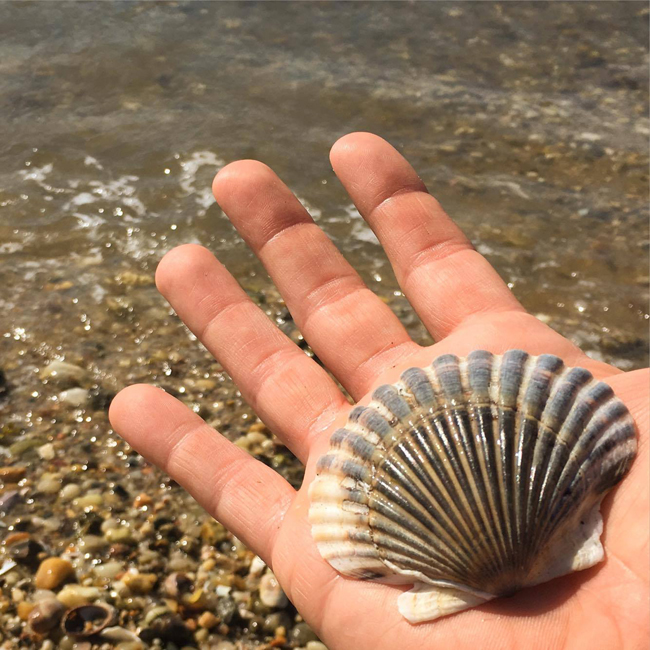
A scallop shell washed ashore in Noyac Bay. Credit: Paul C. Focazio
— By Chris Gonzales, Communications Specialist, New York Sea Grant
Stony Brook, NY, August 30, 2017—A bivalve, for the uninitiated, is an aquatic mollusk—such as an oyster, clam, mussel or scallop—that has a compressed body enclosed within a hinged shell. For the initiated, one pint of shucked oysters is a low-calorie option that lends a robust flavor—along with some leeks and potatoes—to oyster stew. The list of savory recipes for stews, chowders, sauces and the like multiply exponentially when you add in hard clams, mussels and bay scallops.
But these aquatic filter feeders face survival challenges in Long Island’s bays and estuaries due to a number of water quality issues, which scientist Christopher Gobler is examining in a two-year New York Sea Grant-funded study. Gobler is the Associate Dean for Research and a professor at Stony Brook University’s (SBU) School of Marine and Atmospheric Sciences (SoMAS).
In 2016, Gobler began piloting a small craft around Long Island to sample its South Shore Estuary Reserve (SSER) waters from Shinnecock Bay through Great South Bay. The purpose of this journey has been to collect information that could foretell the fate of New York’s three most valuable bivalve fishery species: hard clams (Mercenaria mercenaria), eastern oysters (Crassostrea virginica) and bay scallops (Argopecten irradians).
As a means of comparing water quality, Gobler and his team placed sensors—much in the same way a lobsterman floats a buoy—at Stony Brook Southampton’s Marine Lab as well as throughout the Peconic Estuary and Shinnecock Bay. In addition, the investigators have been measuring daily and seasonal variations in the waters’ dissolved oxygen, acidity (pH) and dissolved inorganic carbon levels.
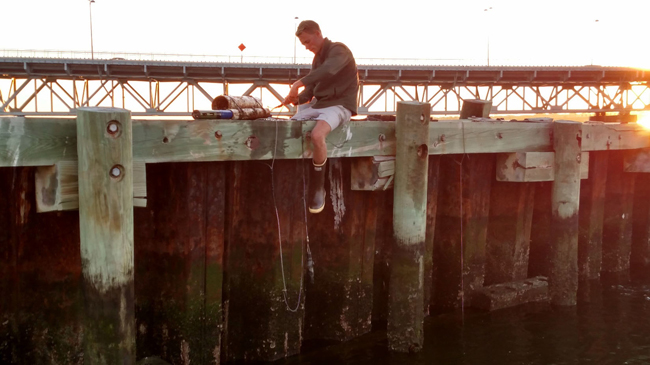
Lab technician Ryan Anderson services a water quality sensor package on western Long Island. Credit: Christopher Gobler
These surveys matter for a number of reasons. While Gobler is still analyzing data, his preliminary results show that an increased presence of algae can degrade the environmental quality of these coastal habitats when this organic matter breaks down. This process is responsible for upsurges in both the water’s carbon dioxide and acidity levels. At sites where microalgae are present at high levels, dissolved oxygen dropped and the water became more acidified over a 24 hour period. However, he also found that seagrass beds appeared to moderate the acidic intensification and provide refuge for bivalves.
“Many of New York’s estuaries already face seasonal acidification and hypoxia,” said Gobler, the latter of which signifies low levels of dissolved oxygen in those waters. “These conditions will intensify with near-term climate change. It is important that regions and species of bivalves least susceptible to these conditions be identified now in order to maximize the resilience of New York’s bivalve populations and seafood supply for the future.”
In laboratory experiments, Gobler’s team set up several study scenarios, including ones in which bivalves in early life stages were grown under normal conditions while others were exposed to various levels of acidity, dissolved oxygen and temperature. In total, the investigators covered all the different combinations of these conditions—a process called full-factorial design—measuring them in this controlled environment every 10 minutes.
Unfortunately for sea-foodies, researchers found that survival of bay scallops was significantly reduced by acidification. Acidity slowed larval growth of the bivalves. However, diurnal simulations—synthetic re-creations of daily and seasonal conditions—did not affect growth or development. Acidic conditions impeded survival of hard clams and caused much more significant effects on survival than any other treatments.
Apart from acidic water, growth and development of hard clams was not significantly affected by other treatment conditions.
Whereas approximately 30 percent of larvae developed in normal conditions, only 13 percent developed in acidic, low-oxygen environments. The survival rate of hard clams was significantly reduced in these adverse conditions.
As for next steps, the team will be trying to identify which bivalve species might best survive in today’s and anticipated future environments with higher acidity and lower oxygen levels. They will also see if they can develop ways to reduce the acidity of the water near shellfish hatcheries.
Additionally, Gobler’s team plans to host a workshop to explain their results to communities and workers in the affected shellfish industry.
In Focus: Gobler's Regions of Study
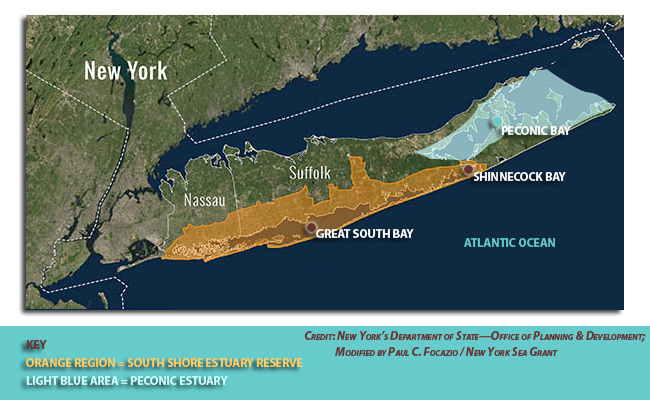
Long Island’s South Shore Estuary Reserve
(the map region marked in orange) extends eastward 75 miles from the
Nassau County/New York City line to the Village of Southampton in
Suffolk County and south to north from the mean high tide line on the
ocean side of the barrier island to the inland limits of the drainage
areas. The barrier islands along the Atlantic Ocean, the estuary’s
shallow interconnected bays and tidal tributaries all provide highly
productive habitats that support the largest concentration of
water-dependent businesses in the State. Water quality in the estuary is
crucial to the health of the commercial and recreational fishing and
shellfishing industries.
The Peconic Estuary system (denoted within the light
blue area) is located between the North and South Forks on eastern Long
Island. The estuary includes more than 100 distinct bays, harbors,
embayments and tributaries, including Flanders Bay, Great Peconic Bay,
Little Peconic Bay, Noyac Bay, Shelter Island Sound and Gardiners Bay.
Excess inputs of nitrogen have caused an imbalance in the estuary, which
results in recurrent algae blooms and related drops in dissolved oxygen
during the summer. This excess nitrogen is also suspected of
contributing to a decline in eelgrass beds.
In Photos: In the Lab and Field with Gobler
Credit: Chris Gobler
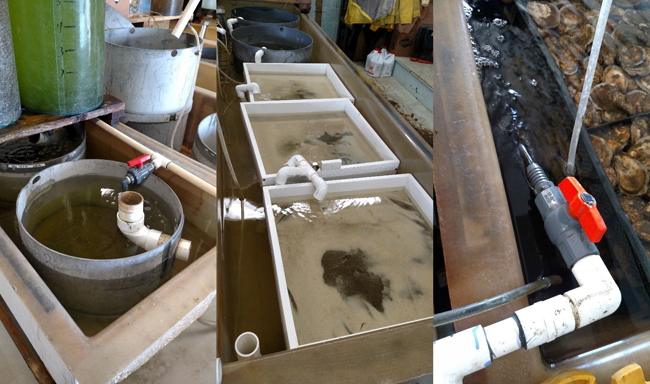
A Upweller system, which consist of individual boxes or silos (pictured in middle photo) for growing juvenile shellfish, with larval and juvenile oysters at a hatchery in Islip, NY. In the background of the intake system (shown at far right) adult oysters are nearly ready.
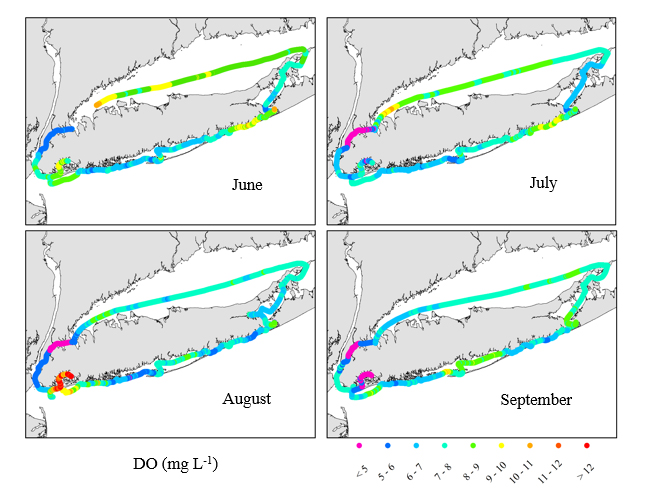
Colors on this map indicate surface water dissolved oxygen around Long Island during summer 2014 (June—September).
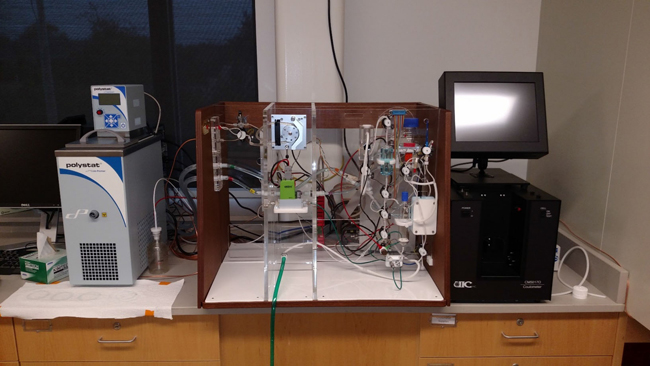
A coulometer is used to determine levels of carbon dioxide in a water sample by measuring electric charges. Of the three places where carbon is stored—atmosphere, oceans and land—approximately 93 percent of the Earth’s carbon dioxide is found in its oceans, where it has an acidic effect.
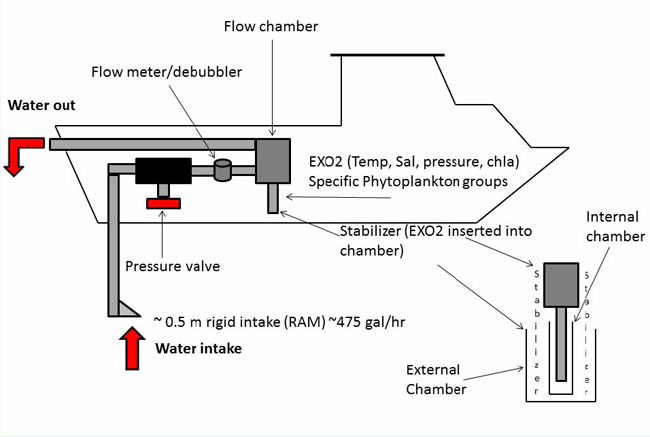
A schematic of the high-speed system used to sample water during Gobler’s studies.
More Info: New York Sea Grant
New York Sea Grant (NYSG), a cooperative program of Cornell University
and the State University of New York, is one of 33 university-based
programs under the National Sea Grant College Program (NSGCP) of the
National Oceanic and Atmospheric Administration (NOAA). The NSGCP
engages this network of the nation’s top universities in conducting
scientific research, education, training and extension projects designed
to foster science-based decisions about the use and conservation of our
aquatic resources. Through its statewide network of integrated
services, NYSG has been promoting coastal vitality, environmental
sustainability, and citizen awareness about the State’s marine and Great
Lakes resources since 1971.
New York Sea Grant maintains Great Lakes offices at SUNY Buffalo, the
Wayne County Cooperative Extension office in Newark and at SUNY Oswego.
In the State's marine waters, NYSG has offices at Stony Brook University
and Stony Brook Manhattan, in the Hudson Valley through Cooperative
Extension in Kingston and at Brooklyn College.
For updates on Sea Grant activities: www.nyseagrant.org has RSS, Facebook, Twitter, and YouTube links. NYSG produces a monthly e-newsletter, "NOAA Sea Grant's Social Media Review," via its blog, www.nyseagrant.org/blog. Our program also offers a free e-list sign up via www.nyseagrant.org/coastlines for its flagship publication, NY Coastlines/Currents, which is published 1-2 times a year.